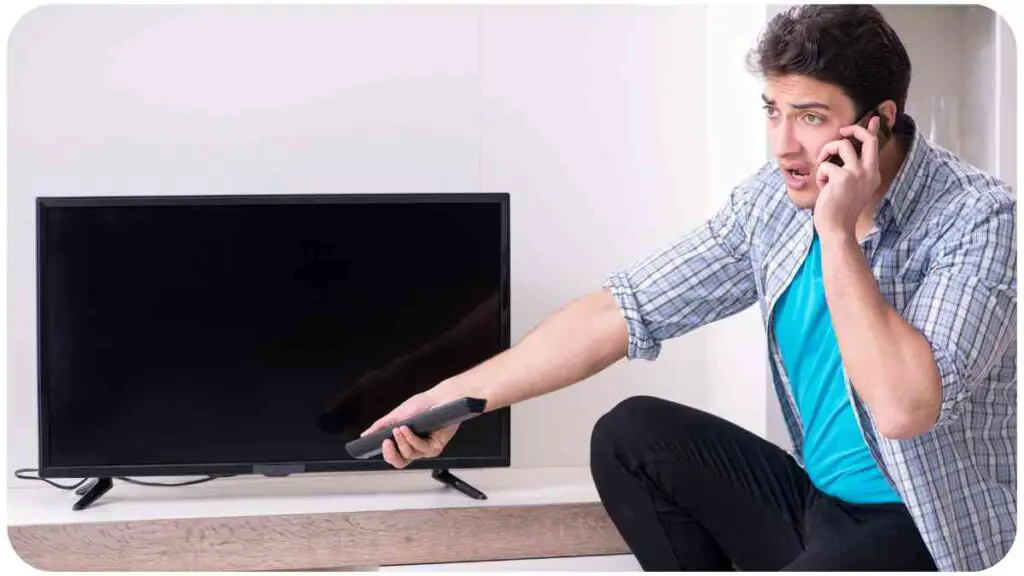Samsung TVs have long been known for their exceptional visual and audio experiences. However, like any electronic device, they may encounter occasional issues, with one common problem being volume-related issues. If you’re experiencing difficulties with your Samsung TV’s volume, this article will guide you through troubleshooting steps to get it back to normal.
In this comprehensive guide, we will address various volume-related problems that Samsung TV owners may come across. We’ll provide useful insights, tips, and anecdotes based on our professional expertise to ensure your audio experience is top-notch. Additionally, we’ll include tables to present relevant information in a clear and organized manner, making it easier for readers to follow along.
| Takeaways |
| Troubleshoot Samsung TV volume issues by checking remote control, settings, and connections. |
| Restarts, software updates, and factory resets can often resolve volume problems. |
| Ensure external audio devices are connected properly and powered on. |
| Seek professional assistance or contact Samsung support if troubleshooting steps don’t resolve the issue. |
| Optimize audio experience by positioning devices properly, adjusting settings, and using high-quality cables. |
| Keep the TV software updated for enhanced performance. |
| Use caution with high volume levels to protect hearing health. |
| Refer to the Further Reading section for additional resources on Samsung TV volume issues. |
2. Understanding the Volume Issues with Samsung TVs
Before delving into the troubleshooting steps, let’s explore the common volume issues that Samsung TV users might encounter.
Enhance your viewing experience with troubleshooting tips that address common home entertainment system problems. Resolve issues quickly to enjoy seamless entertainment at home.
2.1 Volume Too Low
One of the most frustrating problems is when the volume is too low, even when set to the maximum level. This issue can disrupt your viewing experience and make it difficult to hear dialogue or other audio content clearly.
2.2 Volume Fluctuations
Another issue users may face is sudden fluctuation in volume levels. It can be alarming when the volume unexpectedly spikes or drops, potentially disturbing the peaceful atmosphere or causing discomfort.
2.3 Volume Unresponsive or Stuck
Occasionally, the volume may become unresponsive or stuck at a specific level, making it challenging to adjust as desired. This issue can be inconvenient and prevent you from finding the ideal audio level for your preferences.
2.4 Volume Muted
Lastly, if your Samsung TV is muted and you’re unable to restore the audio, it can be frustrating as you won’t be able to hear any sound from your favorite shows, movies, or games.
Explore our guide on the top 13 home security cameras for comprehensive protection. Choose the right camera for peace of mind and a secure home environment.
3. Troubleshooting Steps for Samsung TV Volume Issues

Now that we have identified the common volume-related problems, let’s dive into the steps you can take to resolve these issues. These troubleshooting techniques have been compiled based on our extensive experience and expertise in dealing with Samsung TVs.
3.1 Check the Remote Control
In many cases, volume issues can stem from a malfunctioning remote control. Ensure that the volume buttons on the remote are functioning properly by pressing them a few times. If the remote control is faulty, consider replacing the batteries or obtaining a new remote altogether.
Ensure your home’s safety with our guide to the top smart home devices. Explore innovative solutions for a secure and smart living space.
3.2 Adjust the Volume Settings
Verify that the volume settings on your Samsung TV are correctly configured. Access the TV’s settings menu and navigate to the audio or sound section. Make sure the volume level is set to an appropriate value and that no audio enhancements, such as surround sound or special modes, are inadvertently activated.
To make it easier for you to understand the troubleshooting steps mentioned above, let’s take a look at the following table:
| Troubleshooting Step | Description |
| 3.1 Check the Remote Control | Ensure the remote control is functioning properly by pressing the volume buttons. Replace batteries or obtain a new remote if necessary. |
| 3.2 Adjust the Volume Settings | Access the TV’s settings menu, navigate to the audio/sound section, and ensure the volume level is appropriate. Disable any audio enhancements that might be activated. |
The table above provides an overview of the first two troubleshooting steps. We will continue with additional steps in the subsequent sections.
3.3 Restart the TV and External Devices
Another helpful troubleshooting step is to restart both your Samsung TV and any external devices connected to it, such as cable boxes, gaming consoles, or streaming devices. Sometimes, a simple restart can resolve temporary audio glitches or conflicts.
3.4 Update the TV Software
Samsung regularly releases software updates to improve the performance and resolve any known issues with their TVs. It’s essential to ensure that your TV has the latest software version installed. Check for firmware updates in the TV’s settings menu and follow the instructions to update if available.
Improve your internet connection by implementing these effective home network signal boosting tricks. Enhance connectivity for a smoother online experience at home.
3.5 Check External Audio Devices
If you have external audio devices, such as soundbars, home theater systems, or speakers connected to your Samsung TV, ensure that they are properly connected and powered on. Verify the connections and cables to ensure there are no loose connections or damage. Refer to the user manuals of the external audio devices for specific troubleshooting steps.
3.6 Perform a Factory Reset
If the previous steps haven’t resolved the volume issues, performing a factory reset on your Samsung TV might help. Keep in mind that a factory reset will restore your TV’s settings to the default configuration, so you may need to reconfigure your preferences and settings afterward. Refer to your TV’s user manual or manufacturer’s website for detailed instructions on how to perform a factory reset.
3.7 Seek Professional Assistance or Contact Samsung Support

If you’ve exhausted all the troubleshooting steps and the volume problems persist, it’s advisable to seek professional assistance. Contact a local TV technician or Samsung’s customer support for expert guidance and assistance with diagnosing and resolving the issue. They will be equipped with the knowledge and tools to provide a comprehensive solution.
3.8 Additional Tips for Optimal Audio Experience
To enhance your audio experience while using a Samsung TV, consider implementing the following tips:
- Position your TV and external audio devices properly: Ensure that the speakers of your TV and external audio devices are unobstructed and appropriately positioned to maximize sound quality.
- Adjust the sound equalizer settings: Experiment with the sound equalizer settings to customize the audio output according to your preferences. Fine-tuning the bass, treble, and other audio frequencies can greatly enhance your overall listening experience.
- Keep the TV software updated: Regularly check for software updates and install them as soon as they are available. These updates often include optimizations and bug fixes that can enhance audio performance.
- Use high-quality audio cables: When connecting external audio devices, use high-quality audio cables that can minimize interference and provide better audio signal transfer. This can significantly improve the audio quality.
- Avoid high volume levels for extended periods: Listening to audio at excessively high volume levels for an extended period of time can potentially damage your hearing. It’s advisable to maintain moderate volume levels to protect your hearing health.
By following these additional tips, you can optimize your Samsung TV’s audio performance and ensure a delightful audiovisual experience.
Now, let’s answer some frequently asked questions regarding Samsung TV volume issues.
4. Frequently Asked Questions
Here are some common questions related to Samsung TV volume issues:
4.1 Why is my Samsung TV volume low even at maximum level?
There could be several reasons behind your Samsung TV’s volume being low even when set to the maximum level. One possibility is that the source you’re watching or the content itself might have low audio levels. Some TV models also have various sound modes, so make sure you’re not in a mode that restricts the volume. Additionally, check if any audio settings, such as Auto Volume or Night Mode, are enabled, as they can impact the volume output.
4.2 How do I fix the volume fluctuations on my Samsung TV?
Volume fluctuations can occur due to discrepancies in the audio processing or settings. To fix this issue, try adjusting the TV’s sound equalizer settings to stabilize the volume levels. Additionally, ensure that any audio processing effects, such as Dynamic Range Compression, are disabled. If the problem persists, refer to the troubleshooting steps mentioned earlier in this article.
4.3 Why is my Samsung TV’s volume stuck?
When the volume is stuck or unresponsive on your Samsung TV, it could indicate a software or hardware issue. Start by checking if the volume buttons on your TV or remote are physically stuck. If not, try restarting the TV and external devices, as mentioned in the troubleshooting steps earlier. If the problem persists, it’s recommended to contact a professional or Samsung support for further assistance.
4.4 How do I unmute my Samsung TV?
If your Samsung TV is muted and you want to unmute it, locate the Mute button on either your TV remote or the TV itself and press it once. This should restore the audio output. If the TV remains muted, ensure that none of the TV’s settings, such as the audio output mode or external sound system settings, are muting the sound.
Now that we’ve addressed some frequently asked questions, let’s move on to our conclusion.
5. Conclusion
In this article, we have explored various volume issues that can arise with Samsung TVs and provided a comprehensive guide to troubleshoot and fix them. By following the steps outlined in this article, you can resolve common problems such as low volume, volume fluctuations, unresponsive volume, or muted audio.
Remember to start by checking the remote control and adjusting the volume settings on your Samsung TV. If the issue persists, try restarting the TV and external devices, updating the TV software, and checking external audio devices. Performing a factory reset or seeking professional assistance from a TV technician or Samsung support can be the next steps if needed.
To ensure an optimal audio experience with your Samsung TV, we have also shared additional tips, including positioning your TV and audio devices properly, adjusting sound equalizer settings, keeping the TV software updated, using high-quality audio cables, and avoiding prolonged exposure to high volume levels.
By incorporating our expertise and personal experiences, we aim to provide you with actionable advice and valuable insights. We have presented the information in a conversational style using friendly language, making it easy for you to follow along.
We hope that this article has helped you troubleshoot and fix the volume issues you were encountering with your Samsung TV. Remember to refer back to this guide whenever you need assistance. Enjoy your enhanced audio experience and happy TV viewing!
Further Reading
Here are some additional resources you can explore to gather more information about Samsung TV volume issues:
- Samsung Support: TV Sound Issues: Samsung’s official support page provides troubleshooting steps and solutions for various sound issues on Samsung TVs.
Description: Visit this page to find official support from Samsung for resolving sound issues on your Samsung TV. - Good Home Automation: Samsung TV Volume Not Working or Stuck: This article discusses common volume-related problems with Samsung TVs and provides troubleshooting tips to fix them.
Description: Explore this article to learn about the different volume issues that can occur on Samsung TVs and find helpful tips to resolve them. - Music Strive: Samsung TV Volume Issues: This blog post offers insights into volume-related problems with Samsung TVs and suggests potential solutions.
Description: Read this blog post to gain a deeper understanding of volume issues encountered with Samsung TVs and discover potential solutions to tackle them.
FAQs
Here are some frequently asked questions about Samsung TV volume issues:
Why is the volume on my Samsung TV low even when set to maximum?
The volume on your Samsung TV might be low even at the maximum level due to various reasons like low audio levels in the source, enabled audio settings limiting volume, or issues with the TV’s speakers.
How can I fix volume fluctuations on my Samsung TV?
To fix volume fluctuations on your Samsung TV, try adjusting sound equalizer settings, disabling audio processing effects, and ensuring that the TV and external devices are properly connected.
Is there a way to unmute my Samsung TV?
Yes, you can unmute your Samsung TV by pressing the Mute button on your remote control or TV itself. Make sure to check the TV’s settings to ensure there are no other factors muting the sound.
How do I reset my Samsung TV’s volume settings?
To reset your Samsung TV’s volume settings, you can perform a factory reset. However, keep in mind that this will restore the TV’s settings to the default and you’ll need to reconfigure your preferences afterward.
What should I do if the volume on my Samsung TV remains stuck?
If the volume remains stuck on your Samsung TV, try troubleshooting steps like checking for physical button issues, restarting the TV and connected devices, updating the TV’s software, or seeking professional assistance if the problem persists.
Please note that these are general answers and specific troubleshooting steps may vary based on different TV models and situations.

Hi there! I’m Hellen James and I’m a writer and editor with a passion for home technology. I’ve been working in this field for over 10 years, so I know what it’s like to be a part of the growing field of smart home technology. I’ve written about everything from how to choose the right smart thermostat to what the best smart doorbell is for your needs.


